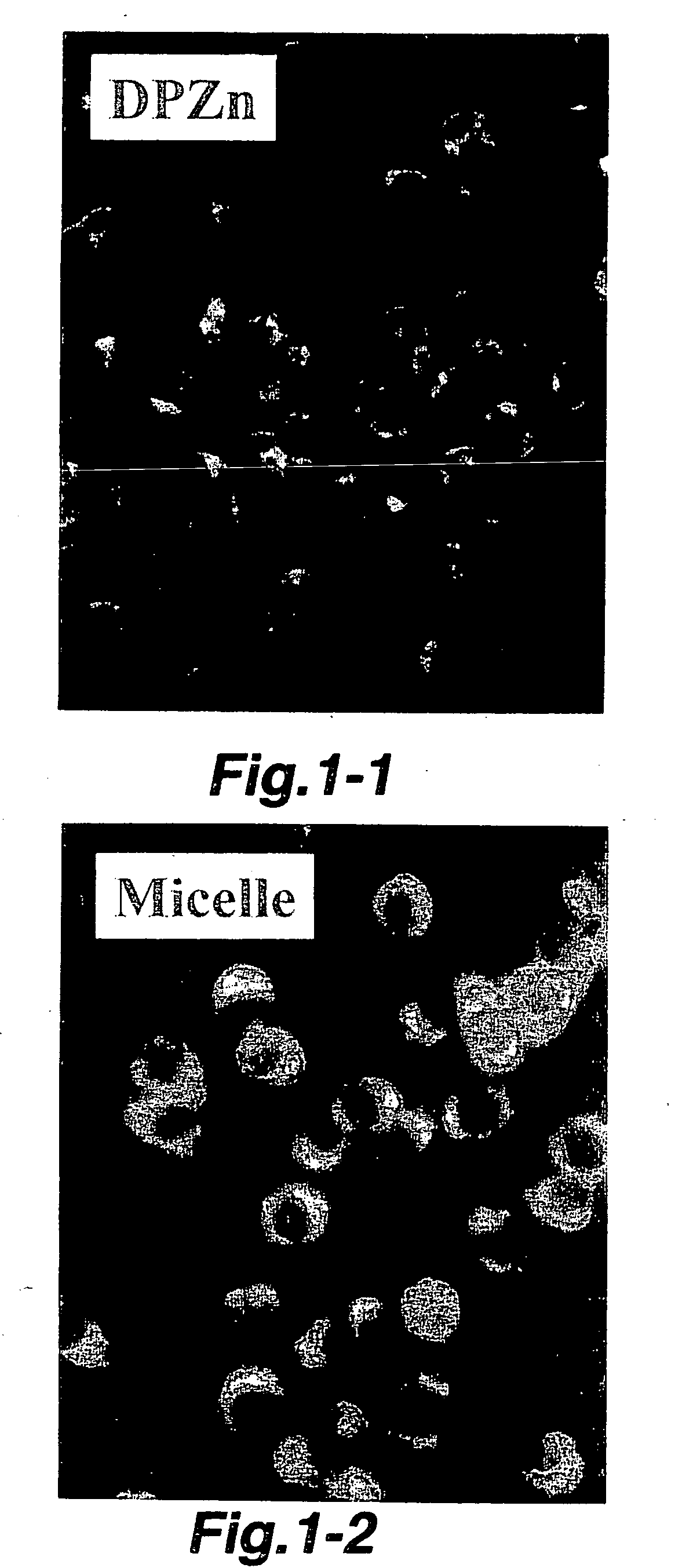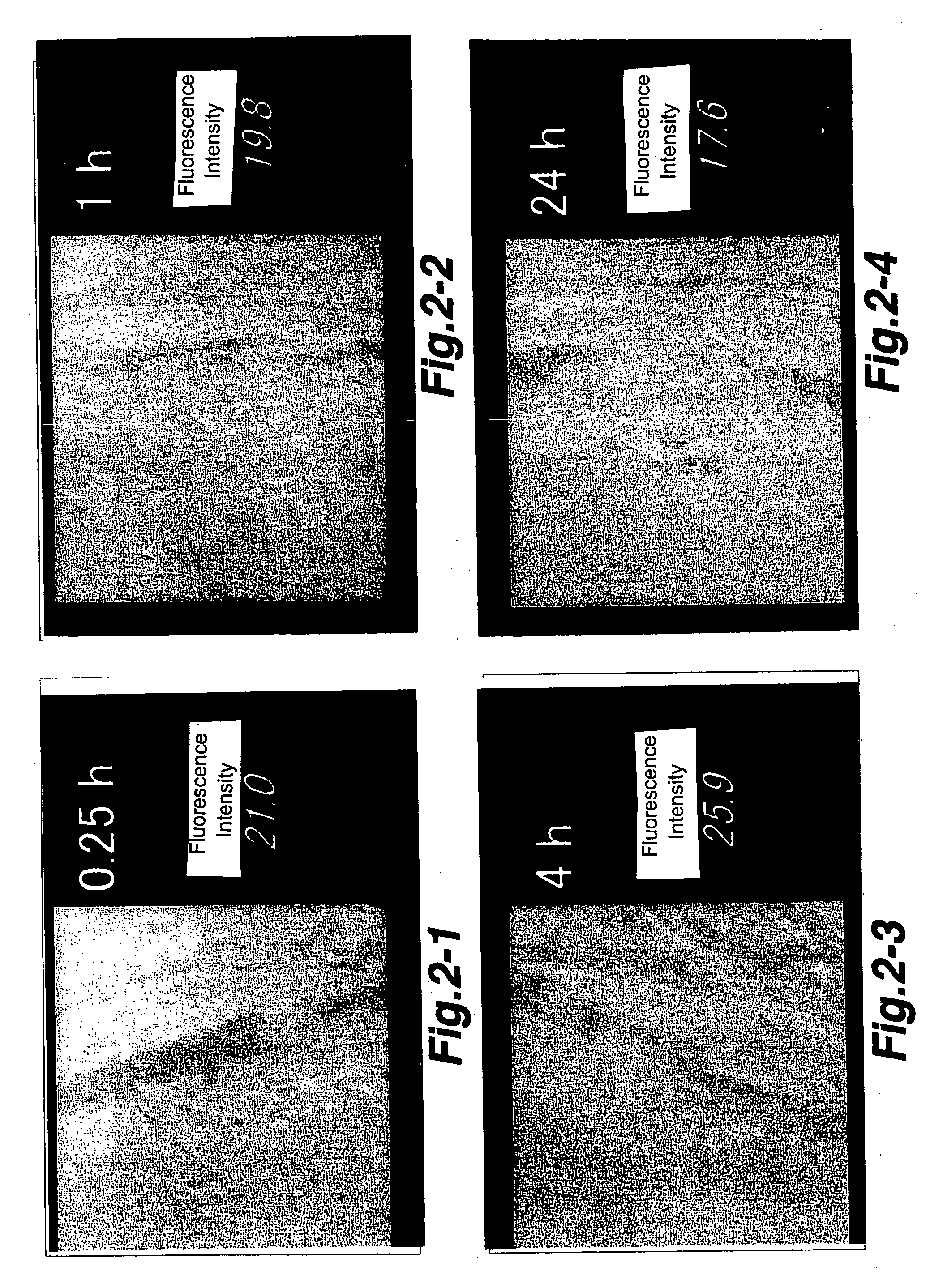Ophthalmic drug delivery system using polymer micell
a technology of ophthalmic drug and micell, which is applied in the direction of drug compositions, biocide, heterocyclic compound active ingredients, etc., can solve the problems of difficult treatment of diseases in such sites, intractable diseases of posterior segments of eyeballs, and ineffective use of drugs in therapy, so as to achieve effective occlusion of new vessels, high accumulation capability of cnv, and the effect of effective therapy
- Summary
- Abstract
- Description
- Claims
- Application Information
AI Technical Summary
Benefits of technology
Problems solved by technology
Method used
Image
Examples
example 1
(Preparation of Fluorescent-Labelled Polymer Micelle)
[0032] A diblock copolymer having polyethylene glycol (PEG) as a hydrophilic polymer chain, and polyaspartic acid (P(Asp)) as an anionic polymer chain within one molecule was dispersed in water, and mixed with FITC-labelled polylysine (FITC-P(Lys)) to prepare a core-shell type PIC micelle solution (5 mg / mL) having a core of a polyion complex (PIC) consisting of P(Asp) and FITC-P(Lys), and a shell of PEG.
(Production of Choroidal Neovascular (CNV) Model)
[0033] After generally anesthetizing a BN rat by intramuscular administration of 1 mL / kg of a mixture of a 5% ketamine hydrochloride injection and a 2% xylazine hydrochloride injection (7:1), eye drops of a 0.5% tropicamide-0.5% phenylephrine hydrochloride ophthalmic solution were administered to render mydriasis. Then, photocoagulation was carried out with a semiconductor laser photocoagulator. Photocoagulation was carried out on six scattering positions per one eye in a poster...
example 2
[0039] Incorporation property into cells was examined using dendrimer-type porphyrin (DP) that is a photosensitive substance as a drug.
(Preparation of Polymer Micelle Incorporating DP)
[0040] Polymer micelle incorporating DP was prepared according to Example 1 described in Japanese Patent No. 3422481 (the same applied to in the following Examples).
[0041] DP used herein is an anionic porphyrin dendrimer [32(−)(L3)4PZn] described in Example 1 in Japanese Patent No. 3422481 (hereinafter, referred to as DPZn).
(Test on Incorporation Property into Cells)
[0042] The polymer micelle incorporating DPZn (hereinafter, referred to as DPZn / polymer micelle), and LLC (Lewis Lung Carcinoma) cells were incubated in phosphate buffered saline in a dark place at 37° for 8 hrs. After washing with a phosphate buffered saline, incorporation into the cells was qualitatively observed by a fluorescence microscope.
[0043] As a comparative control, DPZn and LLC cells were incubated under the same conditio...
example 3
[0045] Using DPZn as a drug, accumulating capability to CNV was examined.
(Method of Administration)
[0046] The DPZn / polymer micelle was intravenously administered in a rat in which CNV was developed according to Example 1.
(Method of Evaluation and Results)
[0047] Following the administration, eyeball was removed at a predetermined time. A frozen tissue section was prepared, and then accumulation to CNV was qualitatively observed by a fluorescence microscope. Consequently, as shown in FIG. 2, high accumulating capability was found agreeing with the CNV site at 0.25 hour, 1 hour, 4 hours and 24 hours after the administration.
PUM
| Property | Measurement | Unit |
|---|---|---|
| particle diameter | aaaaa | aaaaa |
| size | aaaaa | aaaaa |
| wavelength | aaaaa | aaaaa |
Abstract
Description
Claims
Application Information
 Login to View More
Login to View More - R&D
- Intellectual Property
- Life Sciences
- Materials
- Tech Scout
- Unparalleled Data Quality
- Higher Quality Content
- 60% Fewer Hallucinations
Browse by: Latest US Patents, China's latest patents, Technical Efficacy Thesaurus, Application Domain, Technology Topic, Popular Technical Reports.
© 2025 PatSnap. All rights reserved.Legal|Privacy policy|Modern Slavery Act Transparency Statement|Sitemap|About US| Contact US: help@patsnap.com


